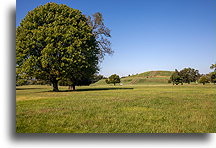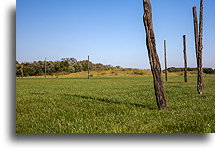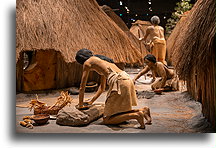Pyramids and other stone structure are characteristics of Mesoamerica, region that stretches from Central Mexico in the north to Honduras and El Salvador in the south. There are no pyramids in North America outside of this region, but there are earthen mounds. Cahokia, Illinois is considered the largest and most complex pre-Columbian settlement in today’s USA and Canada and contains the largest prehistoric mound.
The Mississippian culture raised many communities along the Mississippi River. Cahokia is considered the largest. It dates from AD 700. It is estimated that at its peak, around AS 1050, 10 to 20,000 people lived here. Cahokia was a chiefdom, ceremonial and trade site. The heart of the community was the Grand Plaza. It was a place of public gatherings where the leader could address masses from the largest mound. The top of the Monks Mound was a place from where the paramount chief governed Cahokia and the surroundings region. The Grand Plaza as a sacred place was surrounded by a Stockdale wall. The elite lived inside, the rest of the inhabitants outside the wall. Around 1400 Cahokia was abandoned.



Near the mounds is a reconstruction of a monument originally built at around AD 1150. The Cahokia Woodhenge is a large circle to the west of Monks Mound that contains 48 red cedar posts. It was a local calendar that marked the seasons. The rising sun aligning with certain poles allowed to observe winter and summer solstices. During the spring and autumn equinoxes, the sun emerging from the Monks Mound was intended to create the impression of a link between the sun and the chief, who ruled from the very top of the earthen mound.




